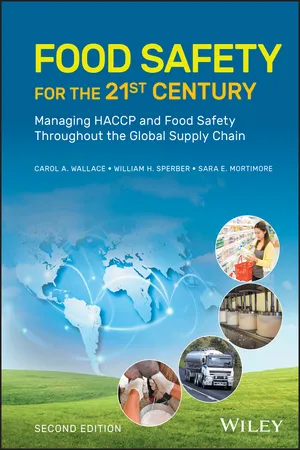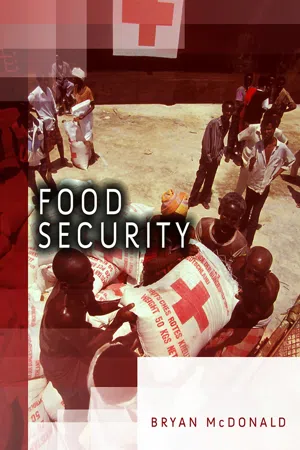Biological Sciences
Contaminated Food
Contaminated food refers to food that has been compromised by the presence of harmful substances, such as bacteria, viruses, parasites, chemicals, or other contaminants. Consumption of contaminated food can lead to foodborne illnesses, posing serious health risks to individuals. Proper food handling, storage, and cooking techniques are essential in preventing food contamination and ensuring food safety.
Written by Perlego with AI-assistance
Related key terms
3 Key excerpts on "Contaminated Food"
- eBook - ePub
Food Safety for the 21st Century
Managing HACCP and Food Safety Throughout the Global Supply Chain
- Carol A. Wallace, William H. Sperber, Sara E. Mortimore(Authors)
- 2018(Publication Date)
- Wiley(Publisher)
Part II Foodborne Hazards and Their ControlPassage contains an image
5 Recognising Food Safety Hazards
5.1 Introduction
A great many hazards of different types may enter the food supply, making the food potentially harmful when consumed. Product development teams, food safety managers, and HACCP teams must be aware of these hazards when developing products and processes and when conducting hazard analyses so that proper control measures can be established as necessary.5.1.1 What is a Food Safety Hazard?
A foodborne hazard is ‘a biological, chemical, or physical agent in, or condition of food with the potential to cause an adverse health effect’ (Codex 2009). The definition is focussed very sharply on food safety considerations. This chapter will describe and explain foodborne hazards according to this globally‐accepted Codex definition.Biological hazards include pathogenic bacteria, fungi, viruses, prions, protozoans, and helminthic parasites. Manifestations of these hazards typically involve foodborne illnesses with symptoms including gastrointestinal distress, diarrhoea, vomiting, and sometimes death.Chemical hazards include allergens, mycotoxins, heavy metals, pesticides, and cleaning and sanitation chemicals. When ingested, these may cause gastrointestinal distress, organ damage, and immunological reactions that may result in death. Long‐term ingestion of foods containing toxic chemicals can lead to chronic effects, including cancer.Physical hazards typically include materials that enter the food throughout its production chain, such as extraneous vegetable material, stones, bone fragments, wire pieces, broken glass, and wood splinters. Their presence in food may result in choking, or oral or internal cuts, but rarely result in death.5.1.2 What is not a Food Safety Hazard?
Many types of quality and regulatory defects that occur during food processing are not considered to be food safety hazards because they would not produce an adverse health effect if such food were consumed. Therefore, these defects are not identified as significant hazards during a hazard analysis, and they are not included in the HACCP plan. Rather, they are controlled by the use of prerequisite programmes (PRPs), as described in Chapter 10 , and specifications and quality control mechanisms. Spoilage microorganisms may produce flavour, odour, and visual defects without making the food harmful for consumption. Souring of milk, putrefaction of meats, gassing of liquid products, and the appearance of microbial colonies on the surface of foods are examples of quality defects. Regulatory defects occur when a food does not conform to the requirements of particular regulations. The presence of certain foreign materials, undeclared nonhazardous ingredients, extraneous vegetable material, or otherwise mislabelled product containers may violate regulations without representing an overt health hazard. Similarly, diluting agents or other ingredients substituted as part of fraudulent activity may not be hazardous although, in this case, the unknown provenance of materials may mean that other unknown hazards could be present (Chapter 13 - eBook - ePub
International Food Safety Handbook
Science, International Regulation, and Control
- Kees Van der Heijden(Author)
- 2019(Publication Date)
- Routledge(Publisher)
Salmonella can be found around the world, even in the most pristine environments. Are these microorganisms and many other so-called pathogens really “contaminants,” i.e., “impurities”? How far is it practically possible to prevent their contact with food around the world?It is probably impossible to eliminate all potential pathogens from the environment. Therefore, primary agricultural products must be considered as potential carriers of such organisms. At the same time, contamination and spread should be prevented, reduced, or limited wherever possible. The lower the pathogen “load” of primary agricultural and fishery products, the less chance that their presence will lead to foodborne disease. Inspection and sorting is not an effective way to prevent raw materials, ingredients, or foods carrying potential pathogens from reaching the consumer, the food processor, or the food handlers (e.g., caterers, hospital, canteen, kitchens, restaurants, snack food operators, etc.). Meat from diseased animals, milk from cows with mastitis, moldy grains, etc. can be recognized and separated. The classical veterinary meat inspection has proved to be very effective. However, there is no reliable way to detect the presence of many bacteria, viruses, mycotoxins, parasites, etc. in or on “normal” animals, raw materials, ingredients, or foods.Table 3 The WHO Golden Rules for Safe Food Preparation1. Choose foods processed for safetyWhile many foods, such as fruits and vegetables, are best in their natural state, others simply are not safe unless they have been processed. For example, always buy pasteurised as opposed to raw milk and, if you have the choice, select fresh or frozen poultry treated with ionizing radiation. When shopping, keep in mind that food processing was invented to improve safety as well as to prolong shelf-life. Certain foods eaten raw, such as lettuce, need thorough washing. - eBook - ePub
- Bryan L. McDonald(Author)
- 2013(Publication Date)
- Polity(Publisher)
6 Optimizing Food Safety: Threats to Health and Food Security from Disease, Contamination, and Biological Weapons The food system, designed to move perishable goods rapidly from producers to consumers, connects many different peoples and places. While the global food system largely provides safe and healthful food, it can also be a means for transmitting threats to human health. Ensuring the health and safety of the food system presents a major challenge to a variety of actors around the world, from producers to consumers and from nations to international organizations. Contamination of food supplies by infectious diseases or chemical hazards can have significant health impacts; each year millions of people become ill or die after consuming Contaminated Food. Illness and contamination of crops, livestock, and food supplies can also have a significant impact on the cost and availability of food and the health of agricultural and food production systems. The global network of food systems, which transfers products rapidly and under controlled environmental conditions, could also serve as a vector for the transmission of biological threats by criminals or terrorists or in cases of biological warfare. Concerns about food safety, like many other challenges to global health and security, have become more complex as a result of globalization processes. As discussed in chapter 2, the establishment of interconnected food systems that link many people and places began long ago as desire for spices, foods, and goods encouraged the establishment of trade routes. In recent decades, however, advances in transportation and communication have enhanced the speed and scale of global interactions. Like many global systems, from the air transit system to post and cargo systems, the food system has been transformed by globalization
Learn about this page
Index pages curate the most relevant extracts from our library of academic textbooks. They’ve been created using an in-house natural language model (NLM), each adding context and meaning to key research topics.


